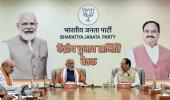Elections are not won or lost by expounding on such macro-economic matters.
For the aam admi, what matters in manifestos are promises that will improve their quality of life, notes Vinayak Chatterjee.

A review of the election manifestos of the leading political parties prior to the 2014 and 2019 general elections makes for interesting reading.
But this is not the occasion to look at the rear-view mirror; rather let's focus on the road ahead through the windscreen of infra-sector requirements.
The most important issue is to clearly recognise the resources the nation would need to invest over the next five years.
To address that issue, three fundamental public expenditure tenets need to be understood, and accepted.
One, during a post-Budget interactions in February 2023, a very senior finance ministry official revealed on national television that the government possessed confidential data indicating that every 1 rupee spent on infrastructure resulted in 3 rupees of gross domestic product (GDP), whereas 1 rupee spent on any kind of direct benefit transfer (DBT) resulted in an addition of 90 paisa to GDP.
Thus, the case for continuing large dollops of public expenditure on infra capex to pump-prime the economy must necessarily continue to be part of the core economic strategy.
Two, it is now widely accepted by mainstream political parties that India's target for investments in infrastructure, or gross capital formation in infrastructure (GCFI), should be at levels of 8 per cent of GDP.
Three, the general thumb-rule in infra spending is that whatever the Union Budget provides as an outlay for infrastructure, a matching amount tends to come from the combined set of states, private capital and extra budgetary resources, including public sector undertakings.
The table attempts to use all these perspectives to provide a quantification of the outlays India would require in the next five years.

The table throws up certain interesting conclusions that political manifestos will have to contend with. These are:
One, India will require to double its infrastructure spending from an expected Rs 20 trillion in FY24 to about Rs 42 trillion by FY29.
Two, the Union Budget should be capable of allocating Rs 21 trillion by FY29, as against the Rs 11.1 trillion announced in the interim Budget.
Three, if there is a desire to shift allocations to the social sector (viz health and education); as well as to agriculture and defence, then serious efforts will have to be made to revive public-private partnership in core infrastructure to keep up the desired levels of overall investments.
However, elections are not won or lost by expounding on such macro-economic matters.
For the aam admi, what matters in manifestos are promises that will improve their quality of life.
For urban voters, the infra-appeal spans across transportation and housing.
The sheer frustration of daily commuting in urban areas is well-known, as is the fact that "metro-rail" projects generally have failed to live up to their promise on various counts.
The overarching solution for urban travel woes is to seriously implement a policy already announced by the government -- viz the Unified Metropolitan Transportation Authority; and relevant choices of inter-linked public transport for the non-metros.
The next pain-point is urban housing. The manifestos should clearly spell-out an aggressive policy for slum redevelopment combined with a re-energised "Awas Yojana" for the less-privileged sections of society.
For rural voters, two broad areas currently hold appeal -- water and rooftop solar, both poised to foster rural livelihoods and entrepreneurship.
The Jal Jeevan Mission (JJM), popularly also known as Nal-Se-Jal, has achieved a high degree of implementation in terms of capex for connectivity.
Now comes the difficult part of life-cycle maintenance and operations.
JJM seeks to embrace the beneficiary population by prescribing a "bottom-up" approach through the formation of Pani Samitis under the gram panchayats, which are to play the key role in planning, implementation, operation and maintenance of the in-village water supply system.
This initiative also involves skill development for a new cadre of plumbers, masons, pump mechanics, and quality control specialists across Bharat, thereby creating a vast job market.
India has approximately 600,000 villages. At 15 new jobs per village, that is an addition of 9 million jobs in rural India.
A similar approach is required in the recently announced policy on rooftop solar by the Prime Minister.
Three national-level policy initiatives also suggest themselves.
The first is implementing the coastal economic zone (CEZ) plan, an impactful idea advocated by Arvind Panagariya during his tenure at NITI Aayog.
These proposed CEZs aim to encourage labour-intensive and export-oriented industries.
The second is a clear emphasis on fostering a green economy, such as a green transition fund, use of green hydrogen, propagation of electric vehicles with supporting charging infra, pump-storage for renewable energy and the like.
And finally, for upgrading the state of civic infrastructure, there is no escaping a determined action-agenda on the issuance of municipal bonds across urban local bodies.
While municipal bonds have been repeatedly mentioned in Budget speeches, a clear action agenda is yet to emerge.
With these aspects covered, manifestos should strive to be relevant and illuminate the pathways to a Viksit Bharat.
Vinayak Chatterjee is an infrastructure expert. He is also the founder and managing trustee of The Infravision Foundation
Feature Presentation: Aslam Hunani/Rediff.com











